#Xiphactinus
Text

It’s Fossil Friday! Let’s swim back in time about 85 million years to the Late Cretaceous Period to meet Xiphactinus, a gigantic predatory fish. This species could reach lengths of 17 ft (5.2 m) and was capable of swallowing a 6-ft- (2-m-) long fish whole!
The Museum’s Xiphactinus fossils come from Logan County, Kansas, which is home to 70-ft- (21.3 m-) tall sedimentary formations. Though that might not sound like an ideal home for an ocean-dweller, the entire area was covered by a vast inland sea during the Cretaceous.
Photo: Image no. ptc-6634 © AMNH (circa 1996)
#science#amnh#museum#fossil#natural history#nature#paleontology#fish#cretac#xiphactinus#did you know#fact of the day#cool animals#ancient animals#ocean life
804 notes
·
View notes
Text




Today's random portfolio artwork is the Xiphactinus section from one of my Mesozoic Monsters murals, in The Children's Museum of Indianapolis. Also features Inoceramus and a school of Caproberyx.
#Art#Painting#PaleoArt#PalaeoArt#SciArt#SciComm#DigitalArt#Illustration#Dinosaurs#Birds#Reptiles#Palaeontology#Paleontology#Xiphactinus
312 notes
·
View notes
Text
Recreating my first ever paleoart

Elasmosaur, me age 5
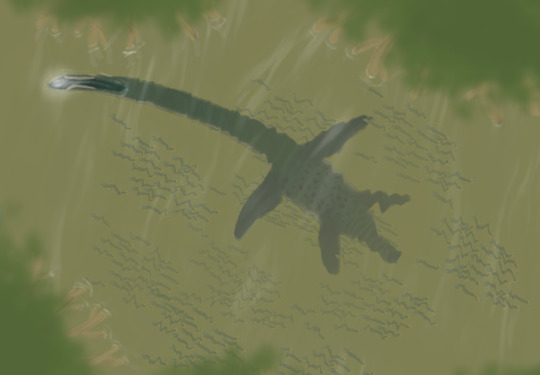
Elasmosaur, me age 10 (almost) years later
#paleoart#elasmosaurus#thalassomedon#plesiosaur#paleontology#fish#mangrove#swamp#ichthyodectes#baby fish#fish fry#xiphactinus#baby xiphactinids#actually more like juvenile
80 notes
·
View notes
Text
#PortfolioDay
It's #PortfolioDay again!!! Hello there, and welcome to my Tumblr gallery!
I'm a palaeoartist who specialises with pterosaurs and maniraptorans, but i also draw other kinds of dinosaurs, marine reptiles, ammonites, mammals, and fish! I also on occasion make skeletals.
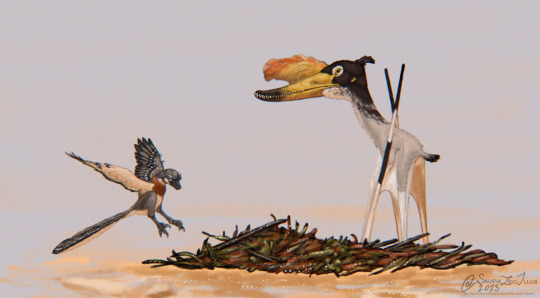
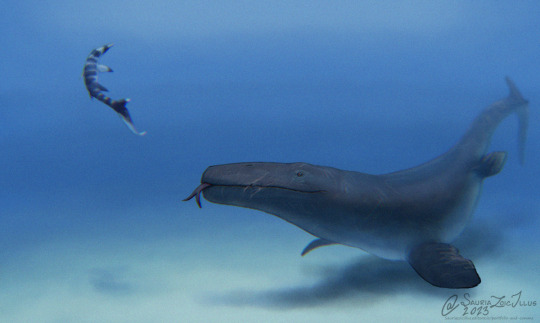
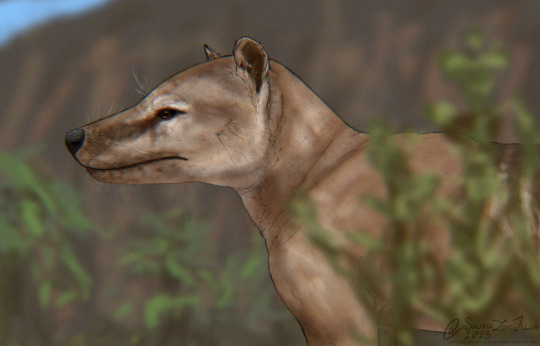

#PortfolioDay#portfolio day#paleoart#palaeoart#paleontology#dinosaurs#sciart#id in alt text#digital illustration#digital artwork#artists on tumblr#digital art#fish art#thylacine#thylacine art#Petrodactyle not Pterodactylus#Xiphactinus#X fish#tylosaurus
83 notes
·
View notes
Text

Paleovember 2023, Xiphactinus!
Also known as the X-fish or the Bulldog fish, Xiphactinus swam the Western Interior Seaway during the Late Cretaceous, and was probably one of the most terrifying fish to ever exist. Not only did it grow up to 20 feet long, it turns out to have an attitude as ugly as it's face; specimens have been found having choked to death on fish way too large for their gullets, and it's likely that their own kind would have been on the menu as well.
#Xiphactinus#western interior seaway#fish#sea monster#late cretaceous#mesozoic#bony fish#paleontology#paleoart#art challenge#animal#illustration#art#artwork#digitalart#creaturedesign#procreate#artist on tumblr
60 notes
·
View notes
Text
Tylosaurus proriger with company
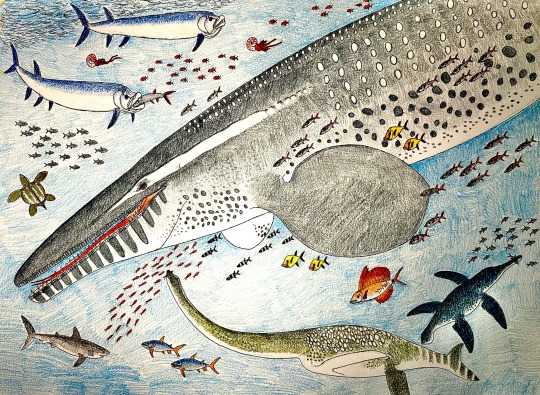
#paleoart#mosasaur#mosasaurs#mosasaurid#tylosaurus#niobrarachalk#late cretaceous#xiphactinus#dolicorhynchops#styxosaurus#protostega#western interior seaway#paleontology#paleontography
119 notes
·
View notes
Text
Welcome back to the Paleo Party! This guest is Xiphactinus! This is one of my favorites! I'm so bummed tho, I had a picture of teeny tiny me in front of one and now I can't find it ;u;
12 notes
·
View notes
Text

A fossilized fish tooth of a Xiphactinus vetus or X-fish from the Blufftown Formation in Barbour County, Alabama, United States. The species of X-fish was originally misidentified as a mosasaur under the species, Polygonodon vetus. Xiphactinus vetus can be distinguished from Xiphactinus audax from the prominent carinae and cross-section shape.
#fish#fossils#paleontology#palaeontology#paleo#palaeo#xiphactinus#polygonodon#x-fish#ichthyodectidae#cretaceous#mesozoic#prehistoric#science#paleoblr#シファクティヌス#クシファクティヌス#イクチオデクテス科#化石#古生物学
13 notes
·
View notes
Text
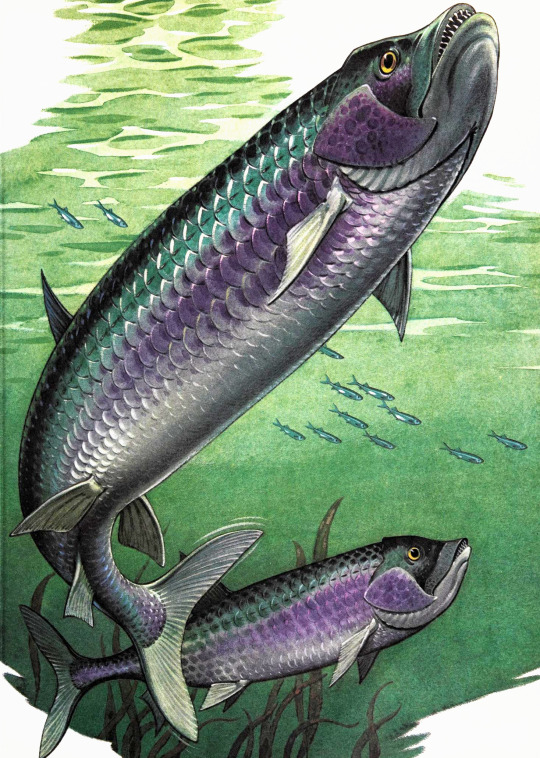
Whales and Giants of the Sea. Written by Rupert Oliver. Illustrated by Bernard Long. 1989.
212 notes
·
View notes
Text
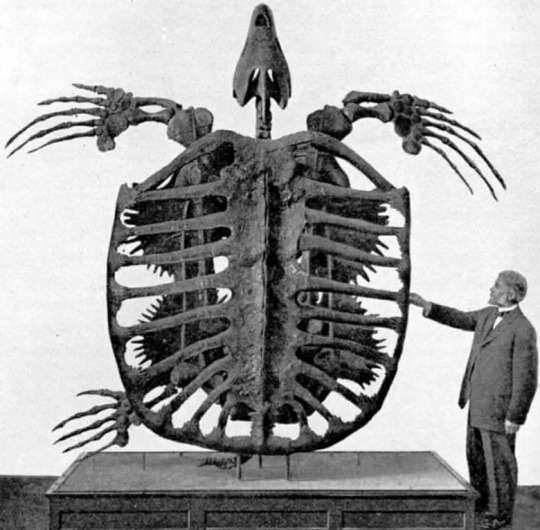
The Yale Peabody Museum of Natural History houses the skeleton of an Archelon ischyros, recognized as the largest turtle to have ever existed. This colossal sea creature bore gear-shaped bones, functioning as stomach bone plates that defended against threats from below. Interestingly, the skeleton displays a missing right lower flipper, with evidence suggesting this was due to an incident in its early life.
This injury potentially occurred during its hatchling phase, either from an attempted bird attack as it made its way to the sea or from a larger predator such as a mosasaur or a Xiphactinus. Estimated to have lived for about 100 years, this Archelon ischyros measured an impressive 15 feet (460 cm) from head to tail, spanned 13 feet (400 cm) from flipper to flipper, and weighed a remarkable 4,900 pounds (2,200 kg).
Living around 80 to 66 million years ago, these magnificent creatures' fossils were discovered in regions now part of South Dakota and Wyoming, once submerged under a shallow sea during the Late Cretaceous period. Their extinction might be linked to increased predation on their land-based eggs and hatchlings, along with a cooling climate, factors that other turtle species managed to endure due to their adaptive thermoregulation capabilities.
#YalePeabody #Museum #skeleton #Archelonischyros #turtle #tortoise #creature #animals #fossils #mosasaur #Xiphactinus #sea #discovered #ancient #history #historical #prehistorical
#Yale Peabody#museum#skeletontortoise#Archelonischyros#turtle#fossils#mosasaur#Xiphactinus#prehistoric#cretaceous
10 notes
·
View notes
Text




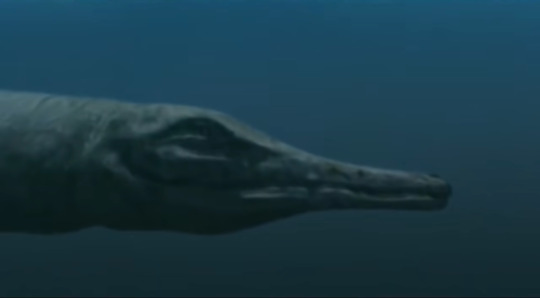
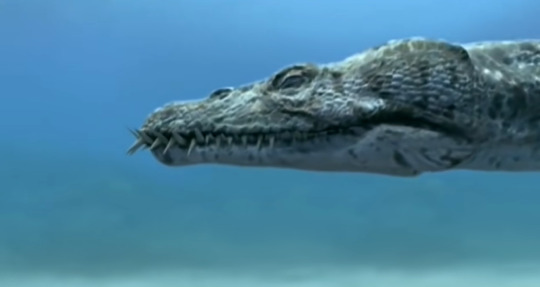








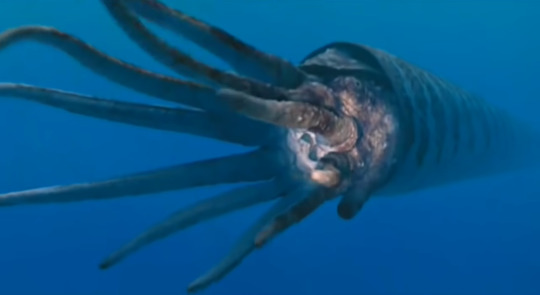

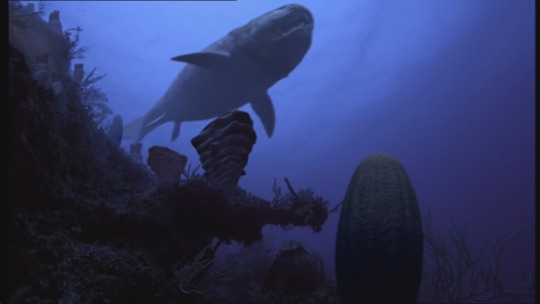
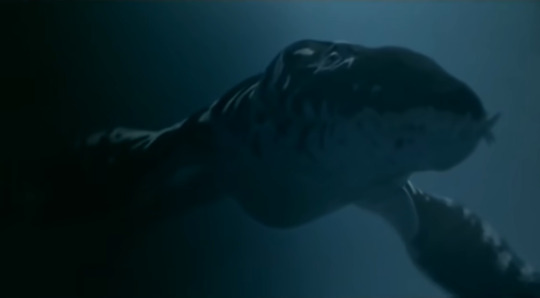


Top twenty sea monsters for the 20th anniversary of Sea Monsters: A Walking With Dinosaurs Trilogy.
#sea monsters#chased by sea monsters#walking with#mosasaur#megalodon#liopleurodon#dunkleosteus#basilosaurus#cymbospondylus#cameroceras#archelon#xiphactinus#leedsichthys#arsinoitherium#megalograptus#pteranodon#elasmosaurus#nothosaurus#metriorhynchus#odobenocetops#hesperornis#tanystropheus#stethacanthus#mine#q
7 notes
·
View notes
Text

Reconstruction of Xiphactinus audax from 2021. Yes, that was the time when I drew a fish. This large (up to 5-6 meters) actinopterygian fish was previously known as Porteus molossus. Its characteristic feature is the forward-thrust lower jaw, which gives a resemblance to a bulldog. Several Xiphactinus specimens have been preserved with the ingested prey inside (in one case 4,2 m. individual swallowed 1,9 m. Gillicus). They could have died because of the resistance of the victims, which led to ruptures of internal organs.
Done with ballpoint pen, colored pencils and watercolors.
#xiphactinus audax#xiphactinus#gillicus#ichthyodectidae#actinopterygii#late cre#late cretaceous#paleoart
10 notes
·
View notes
Photo
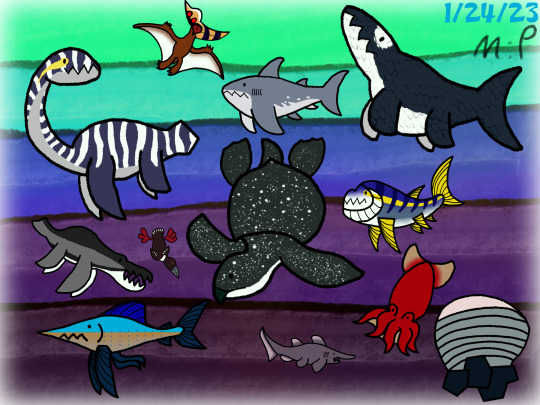
Everyone, do the Niobrara Jive!
#tylosaurus#cretoxyrhina#Geosternbergia#Elasmosaurus#Dolichorhynchops#Protosphyraena#Scapanorhynchus#Inoceramus#Enchoteuthis#Xiphactinus#Archelon#Hesperornis#my artz#Ultra Ramblings#paleoart#paleotology
14 notes
·
View notes
Photo

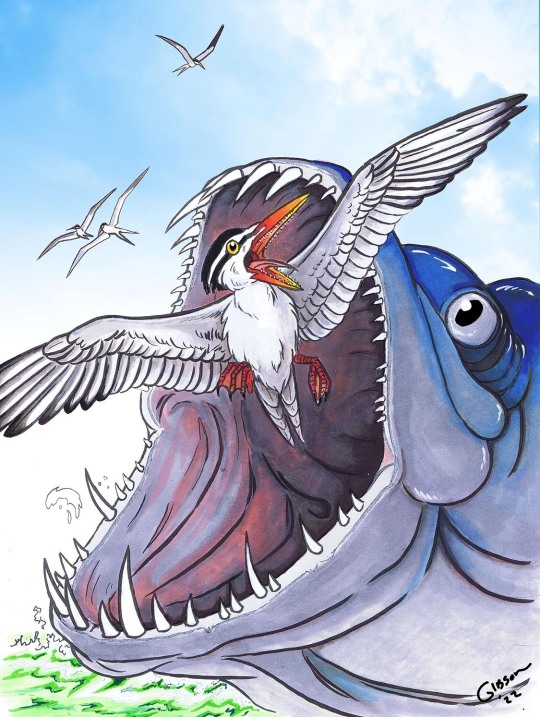
Xiphactinus, for a recent issue of Prehistoric Times.
17 notes
·
View notes
Text
My 2023 Art Highlights
2023 was a pretty rough year for me, but one of the highlights was really finding my style, i feel more confident in my abilities as an artist than ever before
i properly drew 165 animals last year, aiming for a higher number and more diversity this year

#art summary#2023 art summary#art summary 2023#2023 summary of art#paleoart#paleontology#digital art#artists on tumblr#digital artwork#palaeoart#digital illustration#sciart#dinosaur#Balaenognathus#Tselfatia#Seriocrinus#Cymbospondylus#Tamisiocaris#Protoceratops#Xiphactinus#“Styginetta”#Magnapaulia#Coelurus#Irritator#Dinochelys#Stelladens#Tylosaurus#Velociraptor#Prognathodon#Alcmonavis
16 notes
·
View notes
Text
Dibujo de Xiphactinus 🐟
Un enorme pez óseo depredador, y uno muy conocido, vivió en de período cretácico.
Era mesozoica.
género: xiphactinus Especie: xiphactinus Audax.
Año de descubrimiento de la especie:1870

#animals#digital art#art#digital illustration#fish#paleoart#prehistoric animals#marine animals#sealife#mesozoica#xiphactinus
13 notes
·
View notes